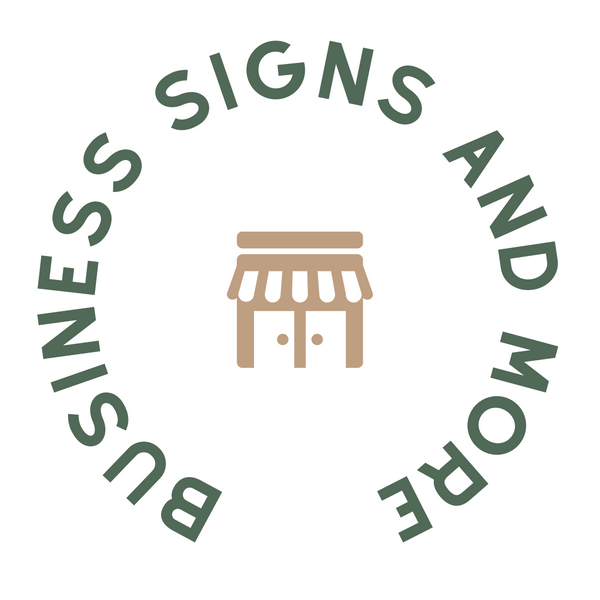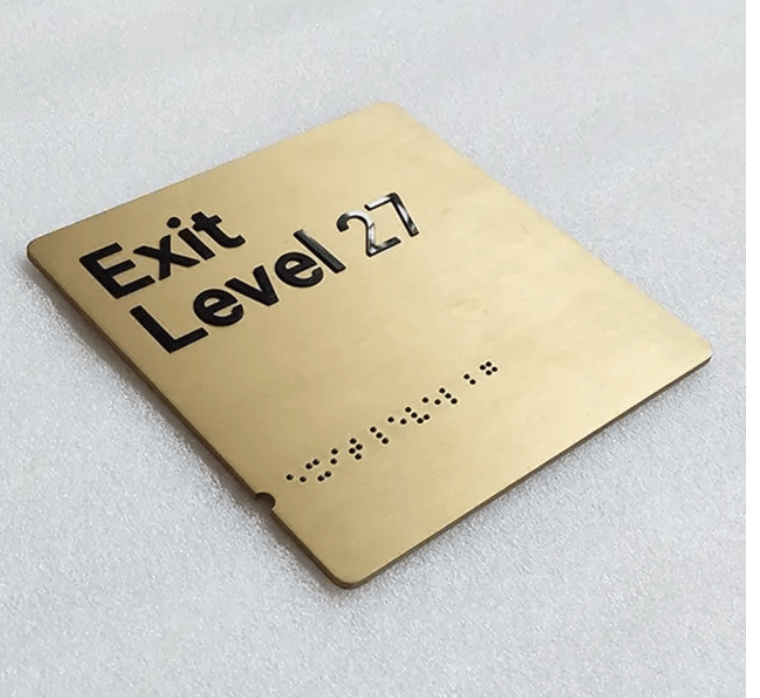Property management is a multifaceted profession, requiring the careful balancing of tenant satisfaction, property upkeep, and operational efficiency. While much of the job involves contracts, maintenance, and communication, one often-overlooked tool in a property manager's toolkit is signage. Thoughtful, well-designed signage not only enhances the aesthetic appeal of a property but also ensures safety, organization, and clarity for tenants and visitors alike.

In this guide, we’ll explore the essential types of signage every property manager should consider, their purposes, and how to choose the best options for different property types. From residential apartment complexes to sprawling commercial properties, effective signage can make a significant difference in property management success.
Business Signs & More specializes in crafting high-quality signage solutions for various sectors:
- Financial Institutions: Professional exterior and lobby signs.
- Government and Military Agencies: Secure and compliant signage.
- Healthcare Facilities: Clear wayfinding and safety signs.
- Restaurants: Branded exterior and menu board signs.
- Hotels and Casinos: Elegant signage for entrances and amenities.
- Schools and Universities: Campus-wide directional and safety signage.
You are welcome to request a quote for property signage pricing.

1. The Role of Signage in Property Management
Signage plays a crucial role in the day-to-day operations of any property. Its applications include branding, safety, navigation, and communication. Here’s a closer look at how signage supports property management goals:
- Branding: Signs that display the property’s name, logo, or tagline contribute to creating a professional and recognizable identity. This is particularly important for commercial properties or upscale residential complexes.
- Safety: Regulatory and safety signs ensure compliance with local laws and protect tenants by providing critical information about fire exits, hazards, or emergency protocols.
- Navigation: Wayfinding signs guide tenants and visitors around the property, reducing confusion and enhancing their experience.
- Communication: Notices about rules, upcoming events, or changes in policy can be effectively conveyed through well-placed signage.
2. Essential Sign Types for Property Management
A. Outdoor Business and Entrance Signs
The entrance to a property sets the tone for tenants and visitors. A high-quality outdoor sign can make a strong first impression while providing critical information.
- Monument Signs: Typically made of durable materials like stone, brick, or metal, monument signs are perfect for marking the entrance to residential complexes, office parks, or shopping centers.
- Post and Panel Signs: These offer a clean, minimalist look and can include the property’s name, logo, and contact details. They’re versatile and easily updated.
- Lighted Signs: Illuminated signs ensure visibility at all hours and are ideal for properties in high-traffic areas or those with 24/7 operations.

B. Wayfinding and Directional Signs
Clear navigation is essential for larger properties or those with multiple buildings or amenities. Directional signs help tenants and visitors find their way easily.
- Parking Lot Signs: These guide drivers to designated parking spaces for residents, guests, or service vehicles. Reflective signs are especially useful for nighttime visibility.
- Building Directories: Placed at property entrances or inside lobbies, directories provide an overview of the property layout and indicate the locations of specific units, offices, or amenities.
- Wayfinding Arrows: Simple yet effective, these signs point toward key areas like leasing offices, pools, or elevators.

C. Regulatory and Compliance Signs
Every property is subject to local laws and regulations regarding safety and accessibility. Compliance signage not only ensures adherence to these laws but also promotes tenant safety.
- Fire Exit Signs: Mandatory for multi-story buildings, these signs direct occupants to the nearest exits in case of an emergency. Glow-in-the-dark or illuminated options are ideal for power outages.
- ADA-Compliant Signs: Properties must include accessible signs with braille, raised text, and clear visibility to accommodate tenants and visitors with disabilities.
- Pool Rules and Safety Signs: For properties with pools, these signs provide critical information, such as hours of operation, depth markers, and safety guidelines.

D. Temporary and Seasonal Signs
Temporary signage is invaluable for communicating short-term updates, promoting events, or marking seasonal changes.
- A-Frame Sidewalk Signs: Perfect for advertising leasing specials, community events, or temporary parking adjustments. They’re portable and easy to update.
- Banners: Large banners can announce grand openings, property upgrades, or seasonal celebrations. They’re versatile and highly visible.
- Window Clings: Ideal for leasing offices or storefronts, window clings can display promotional messages without requiring permanent installation.

E. Property Rules and Etiquette Signs
Maintaining harmony within a property often comes down to clear communication of rules and expectations. Signs can serve as friendly reminders.
- Pet Policy Signs: Indicate pet-friendly areas and provide rules for leash requirements and waste disposal.
- Noise and Quiet Hours Signs: These signs are essential in shared spaces or residential areas with designated quiet hours.
- Trash and Recycling Signs: Help tenants properly dispose of waste and sort recyclables by providing clear instructions near dumpsters or waste stations.

F. Custom Signs for Enhanced Aesthetics
Custom signage allows property managers to elevate the visual appeal of their properties while reinforcing branding.
- Unit Number Plaques: Replace standard unit numbers with custom plaques that reflect the property’s aesthetic, using unique fonts, colors, or materials.
- Lobby and Reception Signs: Create a welcoming atmosphere with branded signs that display the property’s name and logo.
- Seasonal Decor: Incorporate themed signage for holidays or special occasions to foster a sense of community.

G. ADA-Compliant Signage
Ensuring accessibility is both a legal requirement and a sign of inclusivity for property managers. ADA-compliant signage guarantees that all tenants and visitors, regardless of ability, can navigate the property safely and comfortably.
- Braille and Tactile Signs: These signs provide raised lettering and braille to assist visually impaired individuals in finding rooms, restrooms, and other essential areas.
- High-Contrast Signs: Use clear, contrasting colors for easy readability, particularly for individuals with low vision.
- Directional Indicators: Install ADA-compliant wayfinding signs with arrows, ensuring they are mounted at appropriate heights and visible to all users.
- Restroom Signs: Include gender identifiers and accessibility symbols on restroom doors to comply with ADA standards.
- Elevator and Stairwell Signs: Provide braille labels and high-contrast lettering for elevators and stairwells to assist all users in navigating multi-level properties.

3. Key Considerations When Choosing Signage
When selecting signage for your property, consider the following factors to ensure effectiveness and durability:
- Material: Outdoor signs should be weather-resistant, while indoor signs can use more delicate materials. Common options include aluminum, acrylic, and wood.
- Visibility: Signs should be easily readable from a distance. Consider font size, color contrast, and lighting.
- Durability: For long-term signs, invest in materials that can withstand wear and tear. Temporary signs can use more cost-effective options.
- Compliance: Ensure all regulatory signs meet local building codes and safety standards.
- Aesthetics: Signs should complement the overall design of the property, aligning with its branding and architectural style.

4. Benefits of Effective Signage
Investing in high-quality signage offers numerous advantages for property managers, including:
- Enhanced Tenant Satisfaction: Clear and attractive signage creates a more organized and welcoming environment.
- Improved Safety: Proper safety signs reduce the risk of accidents and liability issues.
- Increased Property Value: Professionally designed signs enhance the property’s appearance and marketability.
-
Efficient Operations: Wayfinding and informational signs minimize confusion, saving time for both tenants and property staff.

5. Maintaining Your Signage
Regular maintenance is essential to keep signs looking professional and functioning effectively. Here are some tips:
- Inspect Regularly: Check for damage, fading, or dirt buildup.
- Clean Routinely: Use appropriate cleaning solutions based on the sign material to prevent discoloration.
- Repair Promptly: Address issues like broken lights or missing pieces to maintain a polished appearance.
-
Update as Needed: Replace outdated signs to reflect changes in property branding, rules, or amenities.
6. Partnering with a Signage Provider
Collaborating with a trusted signage provider can streamline the process of designing, producing, and installing signs for your property. Look for providers that offer:
- Custom Design Services: To create signs tailored to your property’s unique needs and branding.
- Durable Materials: Ensure your signs are built to last in their respective environments.
- Ongoing Support: A provider that offers maintenance or replacement services can save you time and effort in the long run.

Conclusion
Signage is an indispensable tool for property managers, offering solutions for branding, navigation, safety, and communication. By investing in high-quality, strategically placed signs, property managers can enhance tenant satisfaction, improve operational efficiency, and boost the overall value of their properties. With careful planning and a trusted signage provider like Business Signs & More, property managers can create an environment that is both functional and visually appealing. Have questions or a property sign idea you'd love to see brought life? Contact us today!

